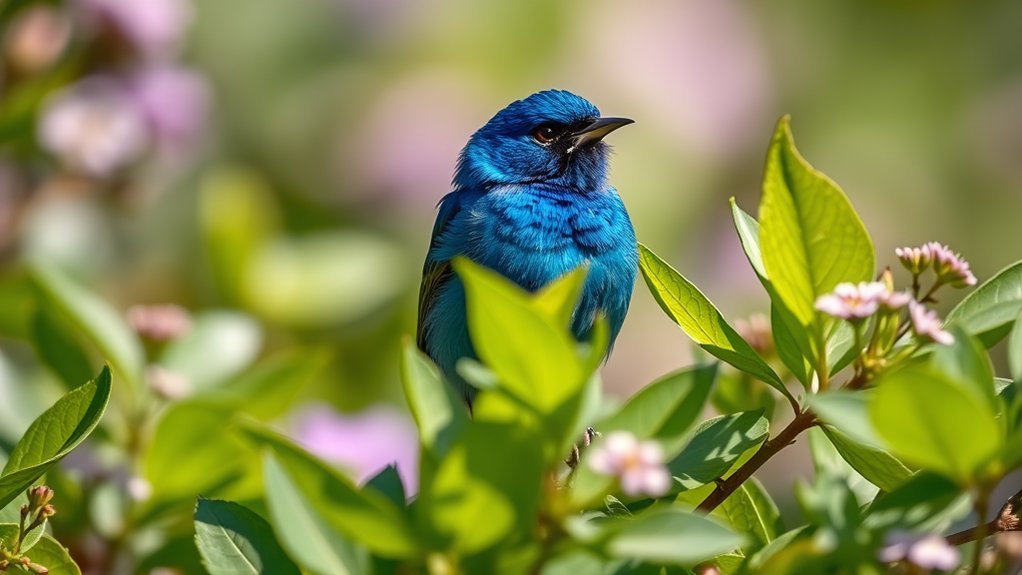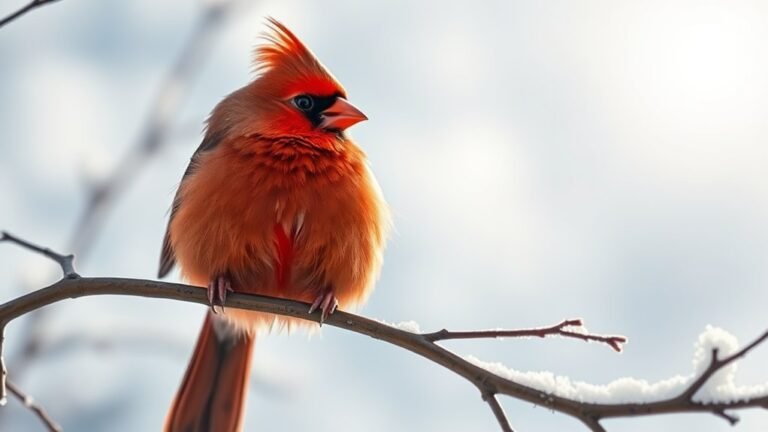12 Beautiful Blue Colored Birds of Texas
In Texas, many blue-colored birds provide interesting examples of how birds adapt and choose habitats. The Eastern Bluebird and the Blue Jay are two notable species, each displaying distinct characteristics and behaviors. Studying their roles in the environment offers important information about how they interact with Texas's ecosystems. While their bright colors may attract attention, the ways they coexist with other species are crucial to understanding their importance. What additional information about these birds can deepen your knowledge of their role in nature?
Key Takeaways
Texas features several blue bird species, including the Eastern Bluebird, Blue Jay, and Indigo Bunting. Each of these birds displays vibrant blue feathers.
The Blue Jay stands out for its intelligence and adaptability. You can find it in urban areas, where it contributes to seed dispersal.
Indigo Buntings are smaller and prefer open habitats. During migration, they often gather in flocks, creating a beautiful sight.
The Blue Grosbeak migrates from the southern U.S. to Central America. It mainly eats seeds throughout its life.
Observing blue birds in Texas allows you to appreciate their beauty. It also highlights the importance of conserving their habitats.
Eastern Bluebird

The Eastern Bluebird (Sialia sialis) is a captivating bird that can be seen year-round, not just in summer.
These birds display bright plumage and interesting behaviors. They typically inhabit open fields, pastures, and edges of woodlands, which provide good nesting sites and food sources.
You can often find Eastern Bluebirds sitting on fences or low branches, watching for insects and berries on the ground.
Their main diet includes insects like crickets and beetles, along with fruits such as blueberries and cranberries, particularly during winter. This flexible diet shows their ability to thrive in different conditions, making them a well-loved part of the Texas bird community.
Observing these birds can deepen your connection to nature, creating a feeling of belonging and joy.
Blue Jay
The Blue Jay (Cyanocitta cristata) is a smart and adaptable bird. Its bright blue feathers and unique calls make it easy to spot. You can see Blue Jays in many places, like forests, parks, and neighborhoods, where they fit well into their environments.
Blue Jays are social animals. They often live in family groups and communicate using different sounds. They enjoy eating acorns and seeds, showcasing their ability to find food. A noteworthy behavior is their practice of storing food for later use.
Blue Jays play an important role in nature by helping disperse seeds and supporting ecosystem health.
With their alertness and beauty, Blue Jays invite you to watch their lively existence in Texas's colorful landscapes.
Indigo Bunting

Seeing an Indigo Bunting (Passerina cyanea) during migration is a breathtaking experience. These small birds display bright blue feathers that catch the eye. They thrive in open woodlands, shrubby areas, and fields, often close to water sources.
In spring and summer, male Indigo Buntings sing to claim their territory and attract mates. Their songs fill the air with pleasant melodies. During migration, they gather in loose flocks, showing their social nature.
You can often see them searching for seeds and insects, illustrating their ability to adapt to different environments. Learning about Indigo Buntings enhances your connection to nature and helps you enjoy the ecosystem that supports these beautiful birds.
Blue Grosbeak
The Blue Grosbeak (Passerina caerulea) is a striking bird that stands out with its vibrant blue feathers.
It's larger than the Indigo Bunting. You can often see Blue Grosbeaks in shrubby areas, field edges, and dense foliage.
They migrate from their breeding grounds in the southern United States to wintering locations in Mexico and Central America.
These birds primarily eat seeds, which is suitable for their strong beaks.
Watching Blue Grosbeaks during migration enhances our connection to nature and deepens our appreciation for the diverse birdlife in Texas and the ecosystems that support them.
Tree Swallow

Tree Swallows (Tachycineta bicolor) are known for their agile flight and bright feathers. In Texas, you can find these birds in open fields near water, where they catch insects in the air.
Each spring, they migrate from Central America to Texas, showcasing their endurance and navigation skills. You can often see them flying smoothly above lakes and rivers.
They roost together in groups, promoting a sense of community among them. Observing these beautiful birds reminds us of their important role in nature, as they help control pest populations and indicate the health of the environment.
Barn Swallow
The Barn Swallow (Hirundo rustica) is a striking bird known for its forked tail and shiny blue feathers.
These birds nest in easy-to-reach places, often using mud to build their homes on buildings and bridges. This habit allows people to feel closer to nature.
Barn swallows migrate long distances, traveling from North America to Central and South America for the winter. This journey shows their strong sense of direction and endurance.
Watching barn swallows can increase your enjoyment of birds and connect you with others who care about protecting these amazing animals.
Purple Martin
Purple Martins (Progne subis) are the largest swallows. They prefer open spaces like fields and cities. These birds often nest in Purple Martin houses built by humans. This connection to man-made structures shows their unique relationship with people.
Purple Martins live in colonies, creating strong social bonds. During courtship, they perform aerial displays that highlight their agility. They mainly eat insects caught in the air, indicating a healthy ecosystem.
Painted Bunting
The Painted Bunting (Passerina ciris) is a vibrant bird found in Texas, known for its five distinct feather colors. These birds have bright plumage with many shades.
They prefer shrubby areas with dense vegetation, where they can find seeds and insects to eat. In spring, they migrate from Central America to Texas to breed.
Spotting a Painted Bunting can enhance your appreciation for nature and wildlife. Learning about their habits and needs can help you connect with Texas' birdlife.
Tufted Titmouse
The Tufted Titmouse (Baeolophus bicolor) is a charming bird that attracts birdwatchers in Texas. It has soft gray feathers and a distinctive crest. You can find this small bird in wooded areas, especially in deciduous forests and parks with plenty of cover.
It prefers environments with oak and hickory trees, which offer food and nesting spots.
The Tufted Titmouse is curious and often forages in groups for insects and seeds. Its cheerful songs add to its appeal and enrich your backyard birdwatching experience.
Connecting with other birdwatchers to share sightings fosters a sense of community. The Tufted Titmouse is a wonderful part of Texas's birdlife, making it a joy to observe.
Black-throated Blue Warbler
The Black-throated Blue Warbler (Setophaga caerulescens) draws birdwatchers in Texas with its vivid colors and active behavior.
During migration, you can often find these birds in dense forests and shrubby areas. They travel from breeding grounds in northeastern North America to winter in the Caribbean and southern U.S.
Their feeding habits are interesting; they primarily look for insects and spiders, moving quickly through the foliage. You might see them flipping leaves to find hidden food, showing their lively personality.
This charming warbler captivates onlookers with its beauty and energetic movements in Texas's varied environments.
Lazuli Bunting
The Lazuli Bunting (Passerina amoena) is a small songbird found mainly in the western U.S. Sometimes, it appears in Texas during migration.
This bird lives in various habitats, such as open woodlands, shrubby areas, and farmlands.
Male Lazuli Buntings have bright blue feathers during breeding season and sing to claim their territory. They often forage on the ground, feeding on insects and seeds.
You may see them in small groups during migration, which offers a chance to meet other birdwatchers.
Watching Lazuli Buntings in their natural environment highlights the beauty of Texas's bird species, creating a sense of community among bird enthusiasts.
Blue-winged Teal
The Blue-winged Teal (Anas discors) is a notable duck species in Texas. This small dabbling duck prefers shallow wetlands, marshes, and ponds. It feeds on seeds and aquatic invertebrates.
During migration, Blue-winged Teals fly in groups and often at high altitudes. They travel south mainly in October and return north by late February.
Knowing about their migration and habitat helps you appreciate these ducks. It can also connect you with other birdwatchers who share a passion for nature and wildlife in Texas.
Frequently Asked Questions
What Is the Best Time to See Blue Birds in Texas?
To spot bluebirds in Texas, look for them during their breeding season from late March to June. During this time, they are more active and easier to see. Also, pay attention in spring and early fall, as many bluebirds migrate during these periods. These times offer better chances to encounter bluebirds in their natural habitats. Enjoy watching these beautiful birds!
Do Blue Birds Migrate, and When?
Bluebirds migrate. They move south in autumn and return north in spring. Their migration patterns differ slightly by species, adding variety to their journey. Bluebirds are a beautiful sight as they travel during these seasons.
What Habitats Do These Blue Birds Prefer?
Blue birds prefer diverse habitats. They thrive in forests, grasslands, and wetlands. Bird watching and habitat conservation play a vital role in supporting these environments. By participating in these activities, you connect with other nature lovers, creating a strong community. Enjoy the beauty of blue birds while helping their habitats flourish.
How Do I Attract Blue Birds to My Backyard?
To attract blue birds, set up bird feeders filled with their favorite seeds. Also, install nesting boxes in quiet and sheltered areas. This will help create a friendly environment that encourages blue birds to visit your backyard. Enjoy watching these beautiful birds as they come to explore and nest in your space!
Are These Blue Birds Endangered in Texas?
Some blue birds in Texas face threats to their populations. However, conservation efforts work to protect them. These initiatives help maintain their numbers. You can contribute by staying informed and participating in local conservation programs. Your involvement can improve their chances of survival in Texas.

Kashvi is a passionate bird enthusiast and nature lover who has been fascinated by the world of birds for years. With a keen eye for detail and a love for learning, Kashvi is dedicated to sharing her knowledge and insights with fellow bird enthusiasts on Avian Enthusiasts. Through her engaging and informative articles, Kashvi aims to inspire others to join her in exploring the fascinating world of birds and to promote a deeper appreciation for these incredible creatures.







